What Are Gravitational Waves?
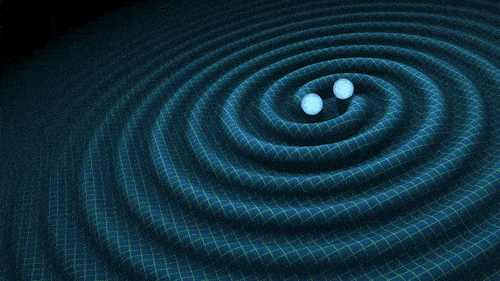
What are Gravitational Waves?
Gravitational waves are ‘ripples’ in the fabric of space-time caused by some of the most violent and energetic processes in the Universe. Albert Einstein predicted the existence of gravitational waves in 1916 in his general theory of relativity.

Einstein’s mathematics showed that massive accelerating objects (such as neutron stars or black holes orbiting each other) would disrupt space-time in such a way that ‘waves’ of distorted space would radiate from the source (like the movement of waves away from a stone thrown into a pond). Furthermore, these ripples would travel at the speed of light through the Universe, carrying with them information about their cataclysmic origins, as well as invaluable clues to the nature of gravity itself.
The strongest gravitational waves are produced by catastrophic events such as colliding black holes,

the collapse of stellar cores (supernovae), coalescing neutron stars or white dwarf stars, the slightly wobbly rotation of neutron stars that are not perfect spheres, and the remnants of gravitational radiation created by the birth of the Universe itself.

hough gravitational waves were predicted to exist in 1916, actual proof of their existence wouldn’t arrive until 1974, 20 years after Einstein’s death. In that year, two astronomers working at the Arecibo Radio Observatory in Puerto Rico discovered a binary pulsar–two extremely dense and heavy stars in orbit around each other. This was exactly the type of system that, according to general relativity, should radiate gravitational waves. Knowing that this discovery could be used to test Einstein’s audacious prediction, astronomers began measuring how the period of the stars’ orbits changed over time. After eight years of observations, it was determined that the stars were getting closer to each other at precisely the rate predicted by general relativity. This system has now been monitored for over 40 years and the observed changes in the orbit agree so well with general relativity, there is no doubt that it is emitting gravitational waves.

Since then, many astronomers have studied the timing of pulsar radio emissions and found similar effects, further confirming the existence of gravitational waves. But these confirmations had always come indirectly or mathematically and not through actual 'physical’ contact.
That was the case up until September 14, 2015, when LIGO, for the first time, physically sensed distortions in spacetime itself caused by passing gravitational waves generated by two colliding black holes nearly 1.3 billion light years away! LIGO and its discovery will go down in history as one of the greatest human scientific achievements.

How are gravitational waves detected?
When a gravitational wave passes by Earth, it squeezes and stretches space. LIGO can detect this squeezing and stretching. Each LIGO observatory has two “arms” that are each more than 2 miles (4 kilometers) long. A passing gravitational wave causes the length of the arms to change slightly. The observatory uses lasers, mirrors, and extremely sensitive instruments to detect these tiny changes. Watch the animation below to see how this works!

Lucky for us here on Earth, while the origins of gravitational waves can be extremely violent, by the time the waves reach the Earth they are millions of times smaller and less disruptive. In fact, by the time gravitational waves from the first detection reached LIGO, the amount of space-time wobbling they generated was thousands of times smaller than the nucleus of an atom! Such inconceivably small measurements are what LIGO was designed to make. To find out how LIGO can achieve this task, visit LIGO’s Interferometer.
Source: LIGO & spaceplace.nasa.gov
Image credit: LIGO/VIRGO (SXS, the Simulating eXtreme Spacetimes) & NASA/Goddard Space Flight Center
More Posts from Carlosalberthreis and Others
🌟 🎶 Esse amor não tem fim
Já faz parte de mim
Te amo CAPRICHOSO
E vai ser pra sempre assim
Nasci pra amar você
De azul até morrer
Não há um amor maior
Do amor que eu sinto por você! 🎶 💙
The Moon in Motion
Happy New Year! And happy supermoon! Tonight, the Moon will appear extra big and bright to welcome us into 2018 – about 6% bigger and 14% brighter than the average full Moon. And how do we know that? Well, each fall, our science visualizer Ernie Wright uses data from the Lunar Reconnaissance Orbiter (LRO) to render over a quarter of a million images of the Moon. He combines these images into an interactive visualization, Moon Phase and Libration, which depicts the Moon at every day and hour for the coming year.
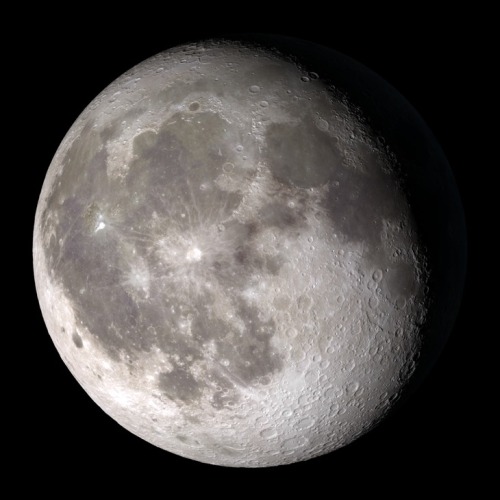
Want to see what the Moon will look like on your birthday this year? Just put in the date, and even the hour (in Universal Time) you were born to see your birthday Moon.
Our Moon is quite dynamic. In addition to Moon phases, our Moon appears to get bigger and smaller throughout the year, and it wobbles! Or at least it looks that way to us on Earth. This wobbling is called libration, from the Latin for ‘balance scale’ (libra). Wright relies on LRO maps of the Moon and NASA orbit calculations to create the most accurate depiction of the 6 ways our Moon moves from our perspective.
1. Phases

The Moon phases we see on Earth are caused by the changing positions of the Earth and Moon relative to the Sun. The Sun always illuminates half of the Moon, but we see changing shapes as the Moon revolves around the Earth. Wright uses a software library called SPICE to calculate the position and orientation of the Moon and Earth at every moment of the year. With his visualization, you can input any day and time of the year and see what the Moon will look like!
2. Shape of the Moon

Check out that crater detail! The Moon is not a smooth sphere. It’s covered in mountains and valleys and thanks to LRO, we know the shape of the Moon better than any other celestial body in the universe. To get the most accurate depiction possible of where the sunlight falls on the lunar surface throughout the month, Wright uses the same graphics software used by Hollywood design studios, including Pixar, and a method called ‘raytracing’ to calculate the intricate patterns of light and shadow on the Moon’s surface, and he checks the accuracy of his renders against photographs of the Moon he takes through his own telescope.

3. Apparent Size

The Moon Phase and Libration visualization shows you the apparent size of the Moon. The Moon’s orbit is elliptical, instead of circular - so sometimes it is closer to the Earth and sometimes it is farther. You’ve probably heard the term “supermoon.” This describes a full Moon at or near perigee (the point when the Moon is closest to the Earth in its orbit). A supermoon can appear up to 14% bigger and brighter than a full Moon at apogee (the point when the Moon is farthest from the Earth in its orbit).
Our supermoon tonight is a full Moon very close to perigee, and will appear to be about 14% bigger than the July 27 full Moon, the smallest full Moon of 2018, occurring at apogee. Input those dates into the Moon Phase and Libration visualization to see this difference in apparent size!
4. East-West Libration
Over a month, the Moon appears to nod, twist, and roll. The east-west motion, called ‘libration in longitude’, is another effect of the Moon’s elliptical orbital path. As the Moon travels around the Earth, it goes faster or slower, depending on how close it is to the Earth. When the Moon gets close to the Earth, it speeds up thanks to an additional pull from Earth’s gravity. Then it slows down, when it’s farther from the Earth. While this speed in orbital motion changes, the rotational speed of the Moon stays constant.
This means that when the Moon moves faster around the Earth, the Moon itself doesn’t rotate quite enough to keep the same exact side facing us and we get to see a little more of the eastern side of the Moon. When the Moon moves more slowly around the Earth, its rotation gets a little ahead, and we see a bit more of its western side.
5. North-South Libration

The Moon also appears to nod, as if it were saying “yes,” a motion called ‘libration in latitude’. This is caused by the 5 degree tilt of the Moon’s orbit around the Earth. Sometimes the Moon is above the Earth’s northern hemisphere and sometimes it’s below the Earth’s southern hemisphere, and this lets us occasionally see slightly more of the northern or southern hemispheres of the Moon!
6. Axis Angle

Finally, the Moon appears to tilt back and forth like a metronome. The tilt of the Moon’s orbit contributes to this, but it’s mostly because of the 23.5 degree tilt of our own observing platform, the Earth. Imagine standing sideways on a ramp. Look left, and the ramp slopes up. Look right and the ramp slopes down.
Now look in front of you. The horizon will look higher on the right, lower on the left (try this by tilting your head left). But if you turn around, the horizon appears to tilt the opposite way (tilt your head to the right). The tilted platform of the Earth works the same way as we watch the Moon. Every two weeks we have to look in the opposite direction to see the Moon, and the ground beneath our feet is then tilted the opposite way as well.
So put this all together, and you get this:
Beautiful isn’t it? See if you can notice these phenomena when you observe the Moon. And keep coming back all year to check on the Moon’s changing appearance and help plan your observing sessions.
Follow @NASAMoon on Twitter to keep up with the latest lunar updates.
Make sure to follow us on Tumblr for your regular dose of space: http://nasa.tumblr.com.
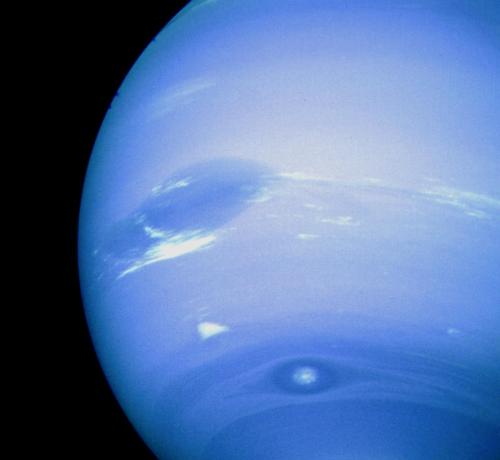
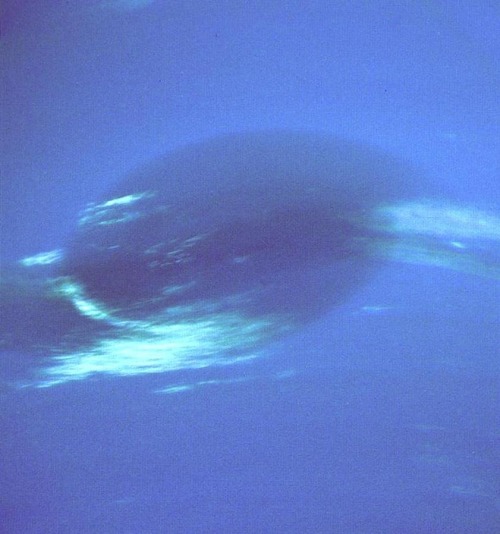
This photograph of Neptune was reconstructed from two images taken by Voyager 2’s narrow-angle camera, through the green and clear filters. At the north (top) is the Great Dark Spot, accompanied by bright, white clouds that undergo rapid changes in appearance.
Credit: NASA

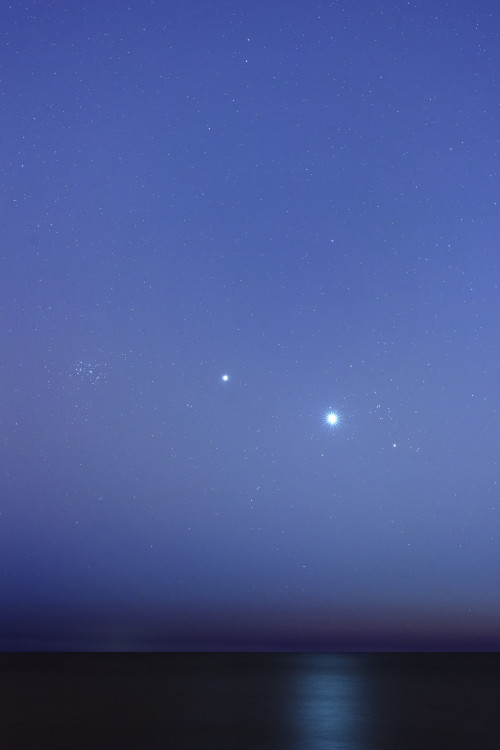
Aldebaran, Venus, Jupiter and Pleiades - Buenos Aires, Argentina.
Image credit: Luis Argerich

Enquanto a Lua passava em frente do Sol durante o eclipse total do dia 21 de Agosto de 2017, um fotógrafo da NASA capturou uma foto que pode ser considerada mais rara do que o próprio eclipse.
Joel Kowsky, um dos editores de fotografia da agência, foi até Banner no Wyoming, para ver o eclipse total do Sol, quando ele fotografou a Estação Espacial Internacional passando na frente do Sol crescente.
Abaixo você pode ver um vídeo que foi feito usando uma câmera de alta velocidade que registrou 1500 frames por segundo. Ele também fotografou a ISS com uma câmera padrão.
Essa alta velocidade é necessária pois a ISS tem o tamanho de um campo de futebol, orbita a Terra a cerca de 300 km de altura e se move a uma velocidade 17500 milhas por hora.
Para fazer esse belo registro é necessário um pouco de sorte e meses e meses de planejamento.
ffff%v;��X
Nessa quarta-feira, dia 27 de Julho de 2016, às 6:00 da manhã, hora de Brasília, o Electrical Support System Processor Unit, ou ESS, da sonda Rosetta será desligado.
O ESS, é a interface usada para realizar, ou pelo menos tentar as comunicações entre a sonda e o módulo Philae, que permanece em silêncio desde 9 de Julho de 2015.
Esse desligamento já é um preparativo e faz parte das ações que serão realizadas para o encerramento da missão da sonda Rosetta na órbita do cometa 67P/Churyumov-Gerasimenko.
A sonda encontra-se a mais de 520 milhões de quilômetros de distância do Sol e já começa a enfrentar uma perda significante de potência.
Para manter a sonda ativa cientificamente pelos próximos 2 meses, é necessário iniciar o desligamento de alguns sistemas.
Como o módulo Philae, não se comunica desde Julho de 2015, e já foi considerado como estando em hibernação eterna, mesmo com a sonda Rosetta passando bem perto do cometa e tentando comunicação, o ESS foi escolhido para ser desligado, encerrando assim de uma vez a missão do módulo Philae.
Descanse em paz Philae.
(via https://www.youtube.com/watch?v=uNbKPaNob0k)
No programa de hoje vamos ver que nuvens pesadas ou névoas espessas em exoplanetas do tipo Júpiter Quente podem estar evitando que uma substancial quantidade de água atmosférica seja detectada por telescópios espaciais.
Água e exoplanetas, sempre um tema quente, e literalmente quente em se tratando dos Júpiteres Quentes.
Um tipo importante de exoplanetas são os chamados Júpiteres Quentes, esses são exoplanetas que possuem uma massa similar a do planeta Júpiter, porém possuem uma órbita muito próxima de suas estrelas , de modo que a temperatura neles chega fácil a 1100 graus Celsius, significando que qualquer água que eles possam ter estaria na forma gasosa.
Na grande coleção desse tipo de exoplaneta já descobertos, os astrônomos identificaram em alguns a presença de água na atmosfera, mas em outros não encontraram, e isso despertou a curiosidade dos astrônomos, que estão querendo saber o que a atmosfera desses exoplanetas têm em comum de verdade.
Normalmente os astrônomos analisam os dados separadamente de cada exoplaneta, porém, nesse caso, eles notaram que esse tipo de análise não seria conclusiva, já que os métodos usados para analisar e as interpretações variavam.
Os astrônomos então agruparam 19 exoplanetas para normalizar os dados, com todos os exoplanetas combinados foi possível criar um espectro de luz geral médio para o grupo de planetas, assim eles compararam esses dados com modelos que representam uma atmosfera limpa, sem nuvens e com modelos que representam atmosferas com diferentes espessuras de nuvens.
O resultado dessa nova maneira de analisar os dados mostrou que quase todos os exoplanetas apresentavam nuvens ou névoa cobrindo em média, metade da atmosfera.
Em alguns foi possível detectar água acima das nuvens, e poderia ter mais água abaixo também.
A natureza das nuvens não foi ainda definida.
Esse estudo do Hubble é o primeiro a quantificar quanto da atmosfera dos exoplanetas poderia estar coberta por nuvens ou névoa e está de acordo com estudos anteriores feitos com outros telescópios espaciais da NASA.
Qual a importância desse tipo de pesquisa?
Primeiro ela pode ser usada para guiar as observações que serão feitas com outros instrumentos, por exemplo, o JWST, ou seja aqueles exoplanetas que não indicarem a presença de água terão uma prioridade mais baixa na observação.
Além disso o estudo da quantidade de moléculas como a de água na atmosfera desses exoplanetas, pode ajudar os astrônomos a entenderem como se deu a formação deles, lembrem-se, esse é um dos grandes mistérios para quem estuda os exoplanetas, será que eles se formaram nas posições em que são encontrados, ou migraram?
O estudo de exoplanetas é fantástico, e como é ainda relativamente recente, muitas metodologias ainda surgirão para que se possa entender melhor e caracterizar melhor esses mundos espetaculares.
(via https://www.youtube.com/watch?v=CSQTfW33kAA)
Por mais de duas décadas, desde a descoberta do primeiros exoplaneta, os astrônomos já descobriram mais de 3200 desses objetos pelo universo.
Exoplanetas de todos os tipos já foram descobertos, super-terras, júpiteres-quentes, parecidos com Netuno, orbitando, 2, 3 e até 4 estrelas, sistemas com 1, 2 e até 6 planetas. Mas nesse tempo todo, o Proxima b, que estava aqui do nosso lado, nunca tinha sido descoberto, por que?
Não foi por falta de tentar, desde o ano 2000 eles procuram por algum planeta por ali, mas sempre a resposta foi negativa.
Já tentaram encontrar o Proxima b por meio do trânsito e nada, tentaram aplicar a mesma técnica de agora e nada novamente.
Até que em 2013 anunciaram essa descoberta, do exoplaneta mais próximo da Terra. Porém, semanas depois tiveram que voltar e retirar a descoberta, pois não tinham elementos para concluir de forma definitiva que era um exoplaneta.
Por que essa dificuldade?
A estrela Proxima Centauri, é uma estrela do tipo anã vermelha, uma estrela pequena, mas muito ativa, ela tem muitas erupções, gera muito vento estelar e tudo isso acaba criando um ruído nas medições feitas através da técnica do efeito doppler ou da velocidade radial, que confundem os astrônomos.
Era preciso mapear esses fenômenos intrínsecos da estrela, para que eles fossem retirados dos dados e então o exoplaneta poderia aparecer.
Para isso os astrônomos montaram uma campanha inteiramente dedicada a observação da Proxima Centauri, com muitos telescópios, durante um período de 60 dias, além de buscarem dados antigos da estrela.
Com isso, conseguiram confirmar a presença do Proxima b.
Agora, é esperar novas observações, novos dados, novas pesquisas sobre esse que até o momento é o exoplaneta mais esperado da história da astronomia.
(via https://www.youtube.com/watch?v=nT6y8cwTURs)
Ainda estamos em 2015!! hahahah...
Terça, 36 de dezembro de 2015.
-
 sillyhideoutpirate liked this · 10 months ago
sillyhideoutpirate liked this · 10 months ago -
 looookingup reblogged this · 11 months ago
looookingup reblogged this · 11 months ago -
 gregorlenko liked this · 1 year ago
gregorlenko liked this · 1 year ago -
 onlythoughtdaughter reblogged this · 1 year ago
onlythoughtdaughter reblogged this · 1 year ago -
 inagarexclas liked this · 1 year ago
inagarexclas liked this · 1 year ago -
 tiodifurecbi liked this · 1 year ago
tiodifurecbi liked this · 1 year ago -
 bunnyliquefaction liked this · 1 year ago
bunnyliquefaction liked this · 1 year ago -
 ardifulpa liked this · 2 years ago
ardifulpa liked this · 2 years ago -
 septimaseverina reblogged this · 2 years ago
septimaseverina reblogged this · 2 years ago -
 musikunst liked this · 2 years ago
musikunst liked this · 2 years ago -
 xploseof reblogged this · 2 years ago
xploseof reblogged this · 2 years ago -
 nacanowhere liked this · 2 years ago
nacanowhere liked this · 2 years ago -
 cumagloia liked this · 2 years ago
cumagloia liked this · 2 years ago -
 argentarachnids reblogged this · 2 years ago
argentarachnids reblogged this · 2 years ago -
 electrovalence reblogged this · 2 years ago
electrovalence reblogged this · 2 years ago -
 arisaontheinternet reblogged this · 2 years ago
arisaontheinternet reblogged this · 2 years ago -
 niteowl2000 liked this · 2 years ago
niteowl2000 liked this · 2 years ago -
 weidenbruck liked this · 2 years ago
weidenbruck liked this · 2 years ago -
 obviouslycovert liked this · 2 years ago
obviouslycovert liked this · 2 years ago -
 remoteagainbuddy reblogged this · 2 years ago
remoteagainbuddy reblogged this · 2 years ago -
 spaceoutthere reblogged this · 2 years ago
spaceoutthere reblogged this · 2 years ago -
 macafeenix liked this · 2 years ago
macafeenix liked this · 2 years ago -
 madammaursa reblogged this · 2 years ago
madammaursa reblogged this · 2 years ago -
 madammaursa liked this · 2 years ago
madammaursa liked this · 2 years ago -
 adricofalzarius liked this · 2 years ago
adricofalzarius liked this · 2 years ago -
 kkoogg reblogged this · 2 years ago
kkoogg reblogged this · 2 years ago -
 all-too-human-storiesxd reblogged this · 2 years ago
all-too-human-storiesxd reblogged this · 2 years ago -
 eliofval liked this · 2 years ago
eliofval liked this · 2 years ago -
 theadventurousrainbowtraveler reblogged this · 2 years ago
theadventurousrainbowtraveler reblogged this · 2 years ago -
 anorakparkafan reblogged this · 2 years ago
anorakparkafan reblogged this · 2 years ago -
 chica-algo-timida liked this · 2 years ago
chica-algo-timida liked this · 2 years ago
